 I love, love, love sausage. I mean, what self respecting omnivore doesn’t like sausage? You can make it out of venison (one of my favorites), beef, pork, chicken, turkey, duck, etc. I have even had shrimp sausage. But today, by popular demand, we are talking about Chorizo. Chorizo is known for its rich red color and its smoky earthiness with a sweet with a gentle tang,
I love, love, love sausage. I mean, what self respecting omnivore doesn’t like sausage? You can make it out of venison (one of my favorites), beef, pork, chicken, turkey, duck, etc. I have even had shrimp sausage. But today, by popular demand, we are talking about Chorizo. Chorizo is known for its rich red color and its smoky earthiness with a sweet with a gentle tang,
As a little background, chorizo originated in Spain (not Mexico) in the 16th Century. The reason it took so long for chorizo to be created in Spain is because one of the important ingredients, pimentón (paprika) wasn’t available. Spain had to wait until the Spanish explorers and conquistadors brought back the capsicum annuum from the Americas. You see, capsicum annuum is a species of chile pepper – are you really surprised we are using chile peppers???. It is the most common and extensively cultivated of all chiles and includes the largest number of and most sold well-known chiles from hot types, i.e. Cayenne, Chile de Arbol, Jalapenos, New Mexican, Pequin, Poblano, Serranos, Thai, etc. to sweet, i.e. Anaheim, Bell Peppers, Cherry, Hungarian Wax, Nu-Mex, Paprika, Pimento, etc. When the Spaniards returned home to Spain they found that you could dry these little beauties and make pimentón. They also discovered that pimentón not only flavoured the sausages beautifully, but it also had preservative qualities. As a result, pimentón was quickly adopted as an essential sausage ingredient in many of regions of Spain. When the Spanish invaded Mexico they brought pigs and eventually chorizo became emblematic of Mexican foods as well.
Now, Spanish Chorizo is different from Mexican Chorizo. Spanish Chorizo is stuffed into casing (intestine), aged and is more like salami; harder and smokier. Mexican Chorizo, on the other hand, is more akin to a fresh Italian sausage; juicier and spicier. I love both but find myself cooking more with Mexican Chorizo than with Spanish Chorizo. Of course, Spanish Chorizo is perfect for a cheese and meat tray with a little (or a lot – depending upon your preference) wine. 🙂
When we are in El Paso we shop at a fabulous market that has wonderful, house made Chorizo. It is incredibly good. The texture is perfect. It has the right amount of fat to meat ratio. The seasoning is spot on. I usually buy 5 or more pounds on the way to the airport, put in in a cooler and bring it home. Sadly, it never lasts until we get back down to El Paso, so I am stuck using whatever Chorizo they have in the DFW area. It is nowhere near as good. It’s the commercial stuff that has a grainy texture and WAAAYYYYYY too much fat/grease. The flavor is also off. Hence, given we like to cook a lot of Southwestern, Mexican and New Mexican cuisine, we needed to make our own Chorizo. It’s really not that hard and this is what we did.
Ingredients
- 5 fresh cayenne peppers
- 1 lb. lean ground pork
- 1 lb regular ground pork
- 8 oz bacon (I use bacon pieces for this because it’s less expensive)
- 2 heads garlic
- 2 Tbsp cider vinegar
- 2 Tbsp chipotle in adobo
- 2 Tbsp smoked sweet paprika (my preference is La Chinata brand)
- 2 Tbsp ancho chile powder
- 1 Tbsp Hungarian paprika (half sharp)
- 2 tsp. ground coriander
- 2 tsp. ground cumin
- 2 tsp oregano
- 1 tsp. ground white pepper
- 1-1/2 tsp sea salt

Instruction
Now, you can always grind your own pork if you want to make this entirely from scratch, however, I find I can control the fat by selecting different leanness ground pork. So, start by grinding the bacon.
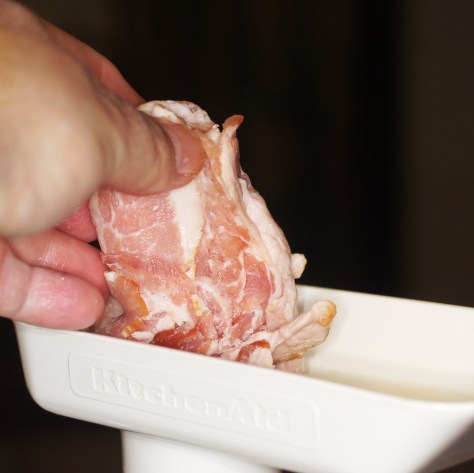
Next, add the garlic to the grinder

followed by the chipotle en adobo.
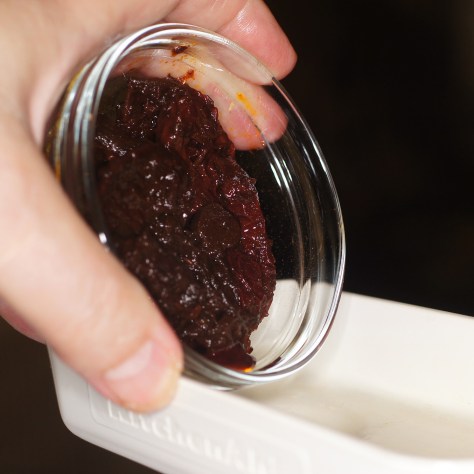
Now, following the recommendation of my friend Stefan, I made my own chipotle en adobo using the recipe by Pati’s Mexican table (we like her a lot) with some minor modification. These homemade chipotles en adobo are fabulous! Next, add some ground pork. This helps clean out the grinder and helps incorporate some of the seasoning.
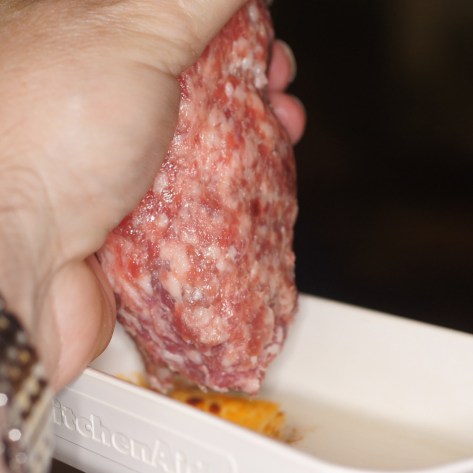
add the cayenne peppers

Then the oregano.
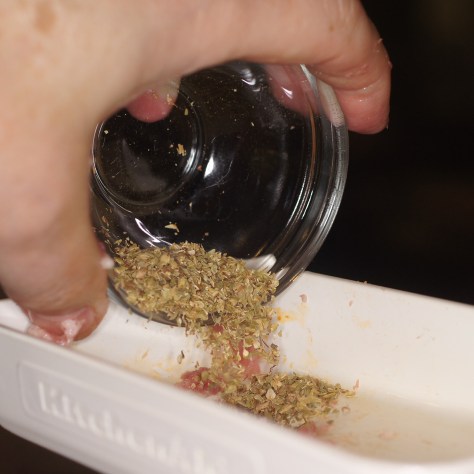
Finally, run the remainder of the ground pork through the grinder alternating between lean and normal. Although this is not really necessary given the pork is already ground, again, it helps clean out the grinder and gets all the seasoning out of the shoot. Now that the pork is in the bowl, add the ancho chile powder

The paprika
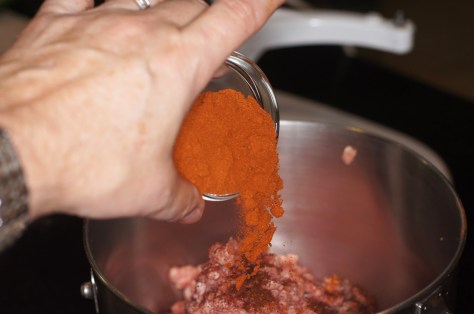
the ground white pepper

the cumin
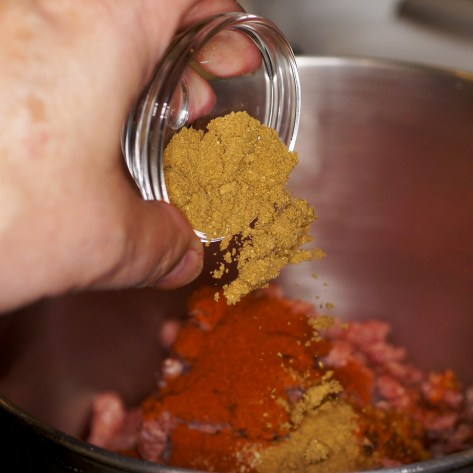
the coriander
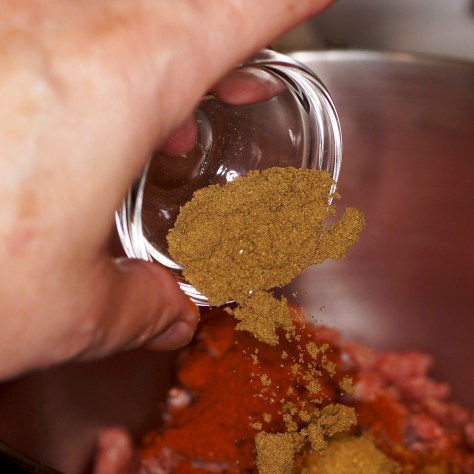
the salt
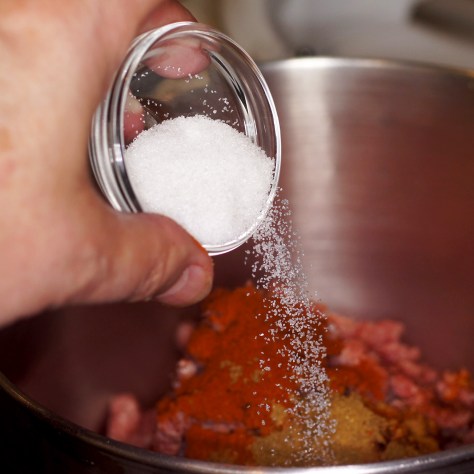
and cider vinegar
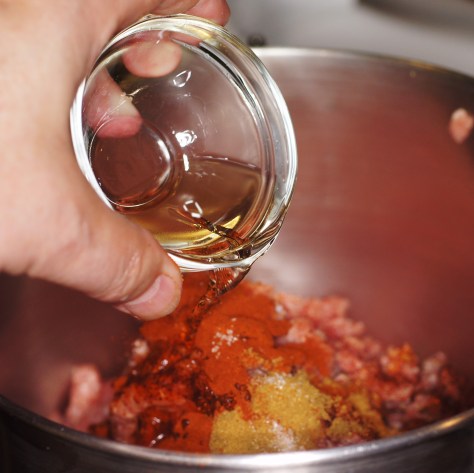
Now, thoroughly mix all of the ingredients to incorporate all of the seasonings. When done, I like to run everything back through the grinder one last time to make sure everything is ground appropriately and incorporated together. Viola!!! Chorizo in bulk. 🙂

NOTES: Now, there are numerous recipes for Chorizo – I found 2.1 million using Google search in less than 3 seconds. Some use cinnamon, cloves, nutmeg or a combination thereof in addition to the spices in this recipe. Others do not use cider vinegar. Others (most) don’t use ancho chile powder but rely upon the flavor of the paprika to season the meat. You can make it however you want but one thing is guaranteed, namely you will like your homemade chorizo a whole lot better than what is commercially available. It’s also cheaper to make your own which is a great added benefit. 🙂 We hope you give this a try.


Great post, Richard! Is there any need to allow the chorizo to age/cure after it has been ground and mixed? Homemade chorizo has been on my list of things to make for a while, so thanks for the reminder 🙂 In Spain (and in the Netherlands) both cured and fresh chorizo are available, apparently only the cured/dried variety gets exported to Texas. Oh and thanks for the shout out, although you did spell my name wrong 😉
Hi Stefan. Sorry about misspelling your name. I can’t believe it when I do that. 😦
The only reason to cure/age the chorizo after it is ground is to make the hard, salami type chorizo. Although not necessary, I do find that if you allow the chorizo to sit in your refrigerator for a day after you make it, the flavors develop better. I think you will really like making your own chorizo. I will be interested to see what seasonings you decide upon when making it.
Delicious, chorizo is the best! Love your “motion shots” putting in all the ingredients 🙂
Thanks for dropping by and your nice compliment. Hope to see you around. 🙂
Hi Richard,
You are back to running on all blogging cylinders. Baby Lady is pin sharp on the photography. I love the detail, the history and I can only imagine the flavours.
Top posting.
Best to you both,
Conor
Thanks Conor. This is something you should try your hand at making one of those mornings you want a Southwestern breakfast. Chorizo and eggs are fabulous together. 🙂
What perfect timing! My husband just bought a meat grinder a couple of weeks ago to make homemade ground beef, and we were discussing trying to make our own Italian and breakfast sausage. But making this Chorizo should be at the top of our list! Very well done, Richard.
Thanks Kathryn. You will have fun making this. I used to make bulk breakfast sausage all of the time when the kids were young. They absolutely loved it and it was much healthier for them than the commercial sausage. When I made this, Daniel reminisced about me making sausage when he was young and asked me why I stopped. I guess I should make more of it. 😉
I love chorizo and use it quite a bit. We have some excellent artisan makers, so making my own has never occurred to me. Maybe one day when there’s nothing to do…
Hi Sandra. If we had someone who made artisan chorizo, I probably never would have bothered with making my own. It is, however, ridiculously simple to make. When you run out of recipes to try or old ones to document, this would be a fun project. 🙂
This is perfect! I was just bemoaning the fact that I couldn’t get Mexican chorizo here! Thanks!
Hi Rosemary. Glad I could help you out. 🙂
Hi Richard, I was going to make this tonight but only have dried cayenne pepper. Do you know approximately how much that would take in lieu of the fresh? I have everything else. Many thanks! (My hubby made breakfast sausages yesterday and we had it for dinner on toast with a fried egg. Yumm!)
Hi Kathryn. The amount won’t change. The difference is that I used the chorizo right after I made it. The fresh chiles add a touch of freshness along with the heat. Dried chiles have to rehydrate or they are tough. They also have a little more earthiness to them. If you mix everything and allow the sausage to sit for anywhere between 2 – 4 hours (longer the better) the dried cayenne with moisten and not be tough. Alas, you will never recapture the freshness but the flavor will be incredibly good nonetheless.
Well I am diving in, wasn’t sure I’d catch you online in time. I’m going to guess 2 teaspoons of dried cayenne. I can always fry a small tad to “test taste” it out. 🙂
Oh, you were referring to ground cayenne pepper. Hmmm…I am clueless. My guess would be 2 tsp sounds about right. It will add more heat than anything else. So, it depends upon your preference.
Yes, that is right, dried ground cayenne. False alarm anyways. Hubby swore we had fresh bacon in the freezer to defrost and alas, we did not. So I’ll be making this tomorrow night instead. Thanks though for the info. I haven’t found fresh cayenne pepper here in Bend.
What did you think about the breakfast sausage?
Not enough sage for the recipe my husband used and too much fennel seed. But I adjusted the amounts on the paper scribblings for next time we make it. I do like that it is healthy (and it was good!) and we could control what went into it. (We also used 1/4 pound of chicken in lieu of full pork.)